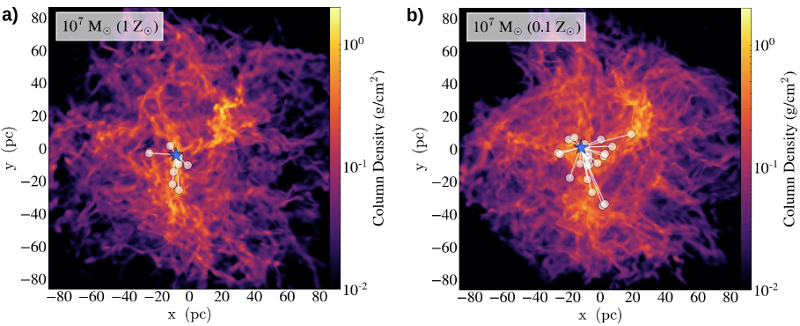
|
EPoS |
|
EPoS Contribution
|
|
The Origin and Growth of Massive Star Clusters
Ralph Pudritz McMaster U, Hamilton, CA | |
| Young massive star clusters (YMCs, with M ≥ 104 M⊙) are proposed modern day analogues of the globular clusters (GCs) that were products of extreme star formation in the early universe.The exact conditions and mechanisms under which YMCs form remain unknown,- a fact further complicated by the extreme radiation fields produced by their numerous massive young stars. Here we show that GC sized clusters are naturally produced in radiation hydrodynamic simulations of isolated 107 M⊙ Giant Molecular Clouds (GMCs) with properties typical of the local universe, even under the influence of radiative feedback. In all cases, these massive clusters grow to GC level masses over just 5 Myr via a roughly equal combination of filamentary gas accretion and mergers with several less massive clusters. Lowering the heavy element abundance of the GMC by a factor of 10 reduces the opacity of the gas to radiation and better represents the high redshift formation conditions of GCs. This results in higher gas accretion leading to a mass increase of the largest cluster by a factor of ~4. When combined with simulations of less massive GMCs a clear relation emerges between the maximum YMC mass and the mass of the host GMC. Our results demonstrate that YMCs, and potentially GCs, are a simple extension of local cluster formation to more massive clouds. | |
 | |
| Caption: The formation of the most massive star cluster and its merging partners. (a): A column density projection of the Z⊙ GMC along the z-axis at t = 1.54 Myr, corresponding to the moment when what will ultimately become the most massive cluster forms. The location of the YMC is shown as the blue star. This cluster initially appears in a high column density filament. The white circles represent the formation locations of the clusters that will eventually merge with the YMC (though these clusters are not necessarily at this location at this time). (b): The same Figure for the 0.1 Z⊙ GMC. | |
| Collaborators: C. Howard, McMaster U, CA B. Harris, McMaster U, CA |
Suggested Session:
Galactic-scale star formation |